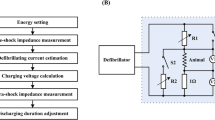Abstract
The findings from the research reported in this paper may be summarized as follows:
Cardiac defibrillation is an electric current oriented phenomenon. There is a preferred cardiac axis for effective defibrillation. The cardiac preferred axis cannot be related easily to body surface electrode placement. More effective methods of defibrillation involve the use of endoesophageal or endotracheal electrodes rather than two body surface electrodes. Impedance measurements of the thoracic region and the heart indicate that low frequency alternating current is probably the most effective defibrillating stimulus. While direct current is effective, there is a greater risk of electrolysis than with alternating current.
Sommaire
Les résultats de recherches présentés dans cet article peuvent être résumés comme suit:
La défibrillation cardiaque est un phénomène lié à l'orientation du courant électrique. Il existe un axe cardiaque préférentiel pour une défibrillation efficace. Cet axe préférentiel n'est pas lié de façon simple à la position d'une électrode de surface. Des méthodes plus efficaces de défibrillation utilisent des électrodes introduites dans l'oesophage ou dans la trachée de préférence aux électrodes de surface. Les mesures d'impédance de la région thoracique et du coeur montrent que l'usage d'un courant alternatif à basse fréquence est probablement le stimulus défibrillateur le plus efficace. Bien que le courant continu soit efficace, il y a un plus grand risque d'électrolyse qu'avec un courant alternatif.
Zusammenfassung
Die in dieser Arbeit mitgeteilten Forschungsergebnisse können folgendermaßen zusammengefaßt werden:
Die Herzdefibrillierung ist ein elektrisches Phänomen. Es gibt eine Vorzugsachse für die wirksame Defibrillierung des Herzens. Die Vorzugsachse des Herzens kann nicht leicht zu der Elektrodenlage auf der Körperoberfläche in Beziehung gesetzt werden. Wirksamere Defibrillierungsmethoden nehmen endoösophageale oder endotracheale Elektroden zu Hilfe, nicht zwei Körperoberflächenelektroden. Impedanzmessungen des Thoraxbereiches und des Herzens ergeben, daß niederfrequenter Wechselstrom wahrscheinlich der wirksamste Defibrillierungsreiz ist. Obwohl Gleichstrom auch wirksam ist, besteht dort mehr als mit Wechselstrom die Gefahr einer Elektrolyse.
Similar content being viewed by others
References
Attar, S., Cowley, R. A., Blair, E. andTischler, M. (1965) Square wave 250 cycle cardiac defibrillator for cardiac surgery.Archs Surg. 90, 29–34.
Balagot, M. D.,et al. (1964) A monopulse DC current defibrillator for ventricular defibrillation.J. Thorac. and Cardiovasc. Surg. 47, 487–504.
Cowley, R. A., Tamres, A. andTischler, M. (1964) Esophageal defibrillation of the canine heart.Bull. Md Univ. Sch. Med. 49, 34–36.
Cowley, R. A., Tischler, M., Attar, S. andTamres, A. (1962) Cardiac defibrillation above sixty cycles with a portable square-wave defibrillator.Surgery 51, 207–209.
Ferris, C. D. Rev. scient. Instrum. 34, 109–111.
Ferris, L. P., King, B. G., Spence, P. W. andWilliams, H. B. (1936) Effect of electric shock on the heart.Electl. Engng. 55, 498–515.
Ferris, C. D. andMellman, S. (1967) Proc. 20th ACEMB, p. 15.3, Boston.
Ferris, C. D., Moore, T. W. andCowley, R. A. (1966) Frequency and power considerations in the use of alternating current defibrillators.Bull. Md Univ. Sch. Med. 51, 36–48.
Ferris, C. D. andMoore, T. W. (1966) Factors involved in ventricular defibrillation by electronic means. Proc. 19th ACEMB, p. 24, San Francisco.
Jaron, D. Private discussion with author.
Jaron, D. et al. (1967) Proc. 20th ACEMB, p. 15·2, Boston.
Kohlrausch, F. (1897)Annln. Phys. Chem. 60, 315–328.
Kouwenhoven, W. B. andMilnor, W. R. (1954) Treatment of ventricular fibrillation using a capacitor discharge.J. appl. Physiol. 7, 253.
Lown, B., Neuman, J., Amarasingham, R. andBerkovitz, V. V. (1962) Comparison of alternating current with direct current electroshock across the closed chest.Am. J. Cardiol. 10, 223–233.
Mackay, R. S. andLeeds, S. E. (1953) Physiological effects of condenser discharges.J. appl. Physiol. 6, 67.
Moore, T. W., Ferris, C. D., Khazei, A. H. andCowley, R. A. (1968) Preferred cardiac axis for electrical stimulation.Bull. Md Univ. Sch. Med. 52, 3–5.
Richardson, P. C. (1967) Proc. 20th ACEMB, p. 15.7, Boston.
Rush, S. et al. (1967) Proc. 20th ACEMB, p. 14.3, Boston.
Schwan, H. P. (1951) Elektrodenpolarisation und ihr Einfluss auf die Bestimmung dielektrischer Eigenschaften von Flussigkeiten und biologischem Material.Z. Naturf. 6b 3, 121–129.
Schwan, H. P. (1957)Electrical Properties of Tissues and Cell Suspensions, Advances in Biological and Medical Physics. Eds.V. J. H. Lawrence andC. A. Tobias. Academic Press, New York.
Schwan, H. P. andFerris, C. D. (1963) Proc. 16th ACEMB, p. 84, Baltimore.
Schwan, H. P. andMaczuk, J. G. (1965). Proc. 18th ACEMB, p. 24, Philadelphia.
Tischler, M., Attar, S., Tamers, A. andCowley, R. A. (1961) A new portable defibrillator above sixty cycles.Bull. Md Univ. Sch. Med. 46, 8–10.
Wiggers, C. J. (1940) The physiological basis for cardiac resuscitation from ventricular fibrillation—method of serial defibrillation.Am. Heart J. 20, 413.
Author information
Authors and Affiliations
Additional information
Supported by U.S. Public Health Grant No. HE-04595.
Rights and permissions
About this article
Cite this article
Ferris, C.D., Moore, T.W., Khazei, A.H. et al. A study of parameters involved in alternating-current defibrillation. Med. & biol. Engng. 7, 17–29 (1969). https://doi.org/10.1007/BF02474666
Received:
Issue Date:
DOI: https://doi.org/10.1007/BF02474666




